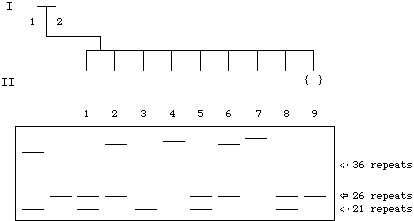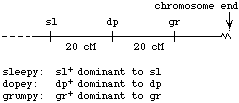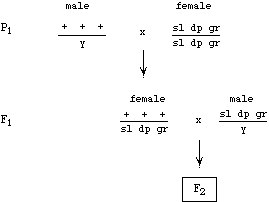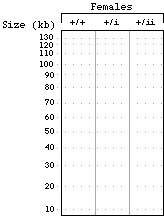|
Genetics 371B, Autumn 2000
Exam 2: 17 November
|
Answer questions 1-4 and EITHER #5 OR #6, but not both.
Click here for answer key
| 1. |
A certain X-linked dominant disease in humans occurs when there are more than 36 repeats of a CAG trinucleotide in a particular gene. The unique sequence flanking the repeat region is as follows:
- 5' AGAGGATCACCAGTACCCAG------(CAG)n-------TCCAACACGTGAGTCTGGAC 3'
- 3' TCTCCTAGTGGTCATGGGTC------(GTC)n-------AGGTTGTGCACTCAGACCTG 5'
|
|
(a) |
Which of the primer(s) from the list below would you would use, if you wanted to PCR-amplify the entire trinculeotide repeat region? (4 pts)
Primer:
#1) 5'-TCTCCTAGTGGTCATGGGTC-3'
#2) 5'-AGAGGATCACCAGTACCCAG-3'
#3) 5'-GTCCAGACTCACGTGTTGGA-3'
#4) 5'-TCCAACACGTGAGTCTGGAC-3'
#5) 5'-(CAG)7-3'
|
|
(b) |
Shown below is the outline of a pedigree for the disease described above, and a representation of a gel showing PCR-amplified fragments detecting the number of CAG repeats. The DNA corresponding to each individual is directly below his or her place in the pedigree. Based on the information you have been given, fill in the pedigree to show the sex and phenotype (affected vs. unaffected) of all individuals except II-9 (save that one for the next question). (10 pts)

|
|
(c) |
What is unusual about individual II-9? Suggest two mechanisms that could explain the genotype of II-9, stating whether that individual would be phenotypically female or male in each case. (6 pts) |
| 2. |
(a) |
A mutation in a bacterial DNA polymerase results in an elevated rate of nucleotide mis-incorporation during DNA replication. Below is a portion of a sequence of newly replicated DNA from this mutant bacterium. "Me" indicates a methyl group on the adenine. (8 pts)
| (i) |
Circle the base mismatch and circle the newly synthesized strand |
| (ii) |
In the space below, write out the corrected DNA sequence after mismatch repair has occurred |
| (iii) |
Write out the two sequences of DNA that would be obtained if DNA replication occurs again before the mismatch is corrected. |
 |
Corrected sequence |
Not corrected, but replicated again |
|
|
(b) |
State whether each of the following mutations would result in dominant , recessive , co-dominant , or incompletely dominant phenotypes for the mutant alleles. Explain BRIEFLY. (6 pts)
| (i) |
The mutation in the DNA polymerase that makes it more error-prone.
|
| (ii) |
A mutation in a restriction enzyme site that creates a restriction fragment length polymorphism (RFLP). |
|
|
(c) |
BRIEFLY explain how a mutation in a tumor suppressor gene can show dominant inheritance in pedigrees and yet be recessive for cancer formation at the cellular level. (6 pts) |
| 3. |
 You have a fish that is heterozygous for three scale traits. Broad (B) is dominant to narrow (b), shiny (D) is dominant to dull (d), and green (G) is dominant to yellow (g). The three loci are located on the same chromosome; the arrangement of alleles in the sperm that gave rise to this fish is shown. The tick marks above the map are spaced 5 cM apart. You have a fish that is heterozygous for three scale traits. Broad (B) is dominant to narrow (b), shiny (D) is dominant to dull (d), and green (G) is dominant to yellow (g). The three loci are located on the same chromosome; the arrangement of alleles in the sperm that gave rise to this fish is shown. The tick marks above the map are spaced 5 cM apart.
The fish is shiny and green with broad scales, as expected, but you notice occasional spots of scales that look different.
|
|
(a) |
What are the two most common types of spots you expect to see in this fish? In what proportions would you expect to see these spots? [HINT: You should be able to answer this part just by looking at the diagram above, before you draw the chromosome diagrams for part (b).] (6 pts) |
|
(b) |
Draw chromosomal diagrams explaining the formation of one of the two spots you have listed in (a). (Your choice of which spot to diagram, but you must state clearly which one you are doing.) (10 pts) |
|
(c) |
What is the least common type of lone spot you expect to see in this fish? In one sentence, say what kind of event would give rise to this type of spot. (No need for diagrams.) (4 pts)
|
| 4. |
Males of the worm C. elegans are XO they have one X chromosome and no Y chromosome, and their sperm have either one X or no X chromosome. You have identified two autosomal recessive mutations: nd-1 causes X chromosome non-disjunction in every cell undergoing meiosis I, and nd-2 causes X chromosome nondisjunction in every cell undergoing meiosis II. For all three questions below, assume that the eggs came from wild type XX animals. |
|
(a) |
What fraction of a +/nd-1 male worm's progeny do you expect will be male (XO)? Explain BRIEFLY. (4 pts)
|
|
(b) |
What fraction of an nd-1/nd-1 male worm's progeny will be male (XO) ? Explain BRIEFLY. (6 pts)
|
|
(c) |
What fraction of an nd-2/nd-2 male worm's gametes can produce offspring with normal chromosome numbers? What will be the sex of these offspring? Explain BRIEFLY. (10 pts) |
Answer Question 5 or Question 6, BUT NOT BOTH. If you answer both, we will not grade #6.
| 5. |
You are working on 3 behavioral genes on the X chromosome of Drosophila :

Wild type males are crossed to completely recessive females. From the progeny of this cross, single females are picked and mated to recessive males, to produce an F2 generation:

|
|
(a) |
Now imagine that the parental wild type male was treated with X-rays, such that his X chromosome acquired a deletion that removed the grumpy locus. In one or two sentences, describe how this deletion would affect the F2 progeny ratios compared to an unirradiated control. (6 pts) |
|
(b) |
Predict the F2 progeny phenotypes and numbers for this deletion strain assuming that you counted a total of 1000 progeny. (14 pts)
|
Answer Question 5 or Question 6, BUT NOT BOTH. If you answer both, we will not grade #6.
| 6. |
The map below represents a 200 kb (kilo-base pair) portion of the mouse X chromosome; SfiI restriction enzyme sites are marked ("SI"). Various deletions (i though iv) found in this portion of the chromosome are shown. The gaps in the bars represent the portions of the DNA that are missing in the deletions, but remember that the breakpoints of the deletion are joined together.

|
|
(a) |
DNA was obtained from various mice (or aborted mouse fetuses), cut with SfiI , and size-separated by gel electrophoresis. For each of the strains (listed above the outline of the gel below), mark the locations of the bands you expect for this segment of DNA. Then circle those bands that will hybridize to the probe shown as a cross-hatched bar in the map. (12 pts)

|
|
(b) |
For some of these deletions (indicated to the right of the map), it was found that female fetuses heterozygous for the deletion died before birth; cell of these fetuses lacked Barr bodies. Where in this segment of DNA is the critical portion of the X inactivation center located? (Give the coordinates in kb from the left end of the map.) Speculate BRIEFLY on why deletions i, iii and iv result in absence of Barr bodies and and in death of the fetus. (8 pts)
|

 You have a fish that is heterozygous for three scale traits. Broad (B) is dominant to narrow (b), shiny (D) is dominant to dull (d), and green (G) is dominant to yellow (g). The three loci are located on the same chromosome; the arrangement of alleles in the sperm that gave rise to this fish is shown. The tick marks above the map are spaced 5 cM apart.
You have a fish that is heterozygous for three scale traits. Broad (B) is dominant to narrow (b), shiny (D) is dominant to dull (d), and green (G) is dominant to yellow (g). The three loci are located on the same chromosome; the arrangement of alleles in the sperm that gave rise to this fish is shown. The tick marks above the map are spaced 5 cM apart.



